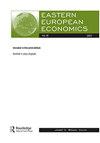出口多样化的决定因素:以俄罗斯地区为例
IF 1.2
4区 经济学
Q3 ECONOMICS
引用次数: 0
摘要
【摘要】油气行业占俄罗斯出口的50%,这给俄罗斯经济带来了较高的大宗商品价格波动风险。先前的文献强调出口多样化在发展和对冲外部冲击中的作用。本文运用矩量分位数回归方法对影响区域出口多样化的因素进行了研究。我们使用Theil和Herfindahl指数设计了两种出口多样化措施。我们的实证结果表明,创新促进了工业地区的出口多元化,而中小企业在工业和非资源地区的出口多元化。自然资源开采使区域出口集中。我们为考虑区域经济专业化的俄罗斯区域决策者提供政策启示。关键词:出口多元化;自然资源;俄罗斯地区;中小企业;ei指数;分类:F14R11致谢本研究得到了俄罗斯科学基金(No: 19-18-00262)的资助。补充材料本文的补充数据可在https://doi.org/10.1080/00128775.2023.2265919Notes1上在线获取。根据“关于俄罗斯联邦中小企业发展”的法律,获得中小企业地位需要满足以下要求。年平均雇用人数:小型企业为16 ~ 100人,中型企业为101 ~ 250人。对年收入有限制:小企业为8亿卢布,中型企业为20亿卢布(经合组织图书馆引文2020)。《对外经济活动商品命名法》(TN - VED)分类是基于4位的商品项目,与国际协调商品名称及编码制度的类似项目相同。基于数据可用性。本研究得到了俄罗斯科学基金会[19-18-00262]的支持。罗格涅达·瓦西里耶娃,经济系高级讲师;俄罗斯叶卡捷琳堡乌拉尔联邦大学区域与国际经济实验室初级研究员。Alina Urazbaeva,法国马赛Kedge商学院;俄罗斯莫斯科国立研究型大学高等经济学院经济科学学院。Valentin Voytenkov,俄罗斯莫斯科国立研究型大学高等经济学院经济科学学院。本文章由计算机程序翻译,如有差异,请以英文原文为准。
Determinants of Export Diversification: The Case of Russian Regions
ABSTRACTThe hydrocarbon sector accounts for 50% of Russian exports, leading to high commodity price volatility risks for the economy. Prior literature emphasizes the role of export diversification in development and in hedging external shocks. We investigate factors affecting regional export diversification, applying method of moments quantile regression. We devise two export diversification measures, using Theil and Herfindahl indices. Our empirical findings demonstrate that innovations spur export diversification in industrial regions, while small and medium enterprises diversify exports in industrial and non-resource regions. Natural resource extraction enforces regional exports concentration. We develop policy implications for Russian regional policymakers considering the specialization of regional economies.KEYWORDS: Export diversificationnatural resourcesRussian regionssmall and medium enterprisesTheil indexJEL Classification: F14R11 AcknowledgmentsThis study was supported by the grant of the Russian Science Foundation No: 19-18-00262 ‘Empirical modelling of balanced technological and socioeconomic development in the Russian regions’Disclosure statementNo potential conflict of interest was reported by the authors.Supplementary materialSupplemental data for this article can be accessed online at https://doi.org/10.1080/00128775.2023.2265919Notes1. According to the law “On the development of small and medium-sized enterprises in the Russian Federation,” the following requirements apply to obtain the status of a small or medium-sized enterprise. An average number of employees per year: 16 to 100 employees for small enterprises and 101 to 250 employees for medium-sized enterprises. A limit applies to annual revenues: 800 million rubles for small enterprises and 2 billion rubles for medium-sized enterprises (OECD iLibrary Citation2020).2. The Commodity Nomenclature of Foreign Economic Activity (rus. TN VED) classification is based on 4-digit commodity items, identical to similar items of the international Harmonized Commodity Description and Coding System.3. Based on data availability.Additional informationFundingThis work was supported by the Russian Science Foundation [19-18-00262].Notes on contributorsRogneda VasilyevaRogneda Vasilyeva, Senior Lecturer, Department of Economics; Junior Researcher, Laboratory of Regional and International Economics, Ural Federal University, Ekaterinburg, Russia.Alina UrazbaevaAlina Urazbaeva, Kedge Business School, Marseille, France; Faculty of Economic Sciences, National Research University Higher School of Economics, Moscow, Russia.Valentin VoytenkovValentin Voytenkov, Faculty of Economic Sciences, National Research University Higher School of Economics, Moscow, Russia.
求助全文
通过发布文献求助,成功后即可免费获取论文全文。
去求助
来源期刊

Eastern European Economics
ECONOMICS-
CiteScore
2.20
自引率
9.10%
发文量
32
期刊介绍:
Eastern European Economics publishes original research on the newly emerging economies of Central and Eastern Europe, with coverage of the ongoing processes of transition to market economics in different countries, their integration into the broader European and global economies, and the ramifications of the 2008-9 financial crisis. An introduction by the journal"s editor adds context and expert insights on the articles presented in each issue.
 求助内容:
求助内容: 应助结果提醒方式:
应助结果提醒方式:


